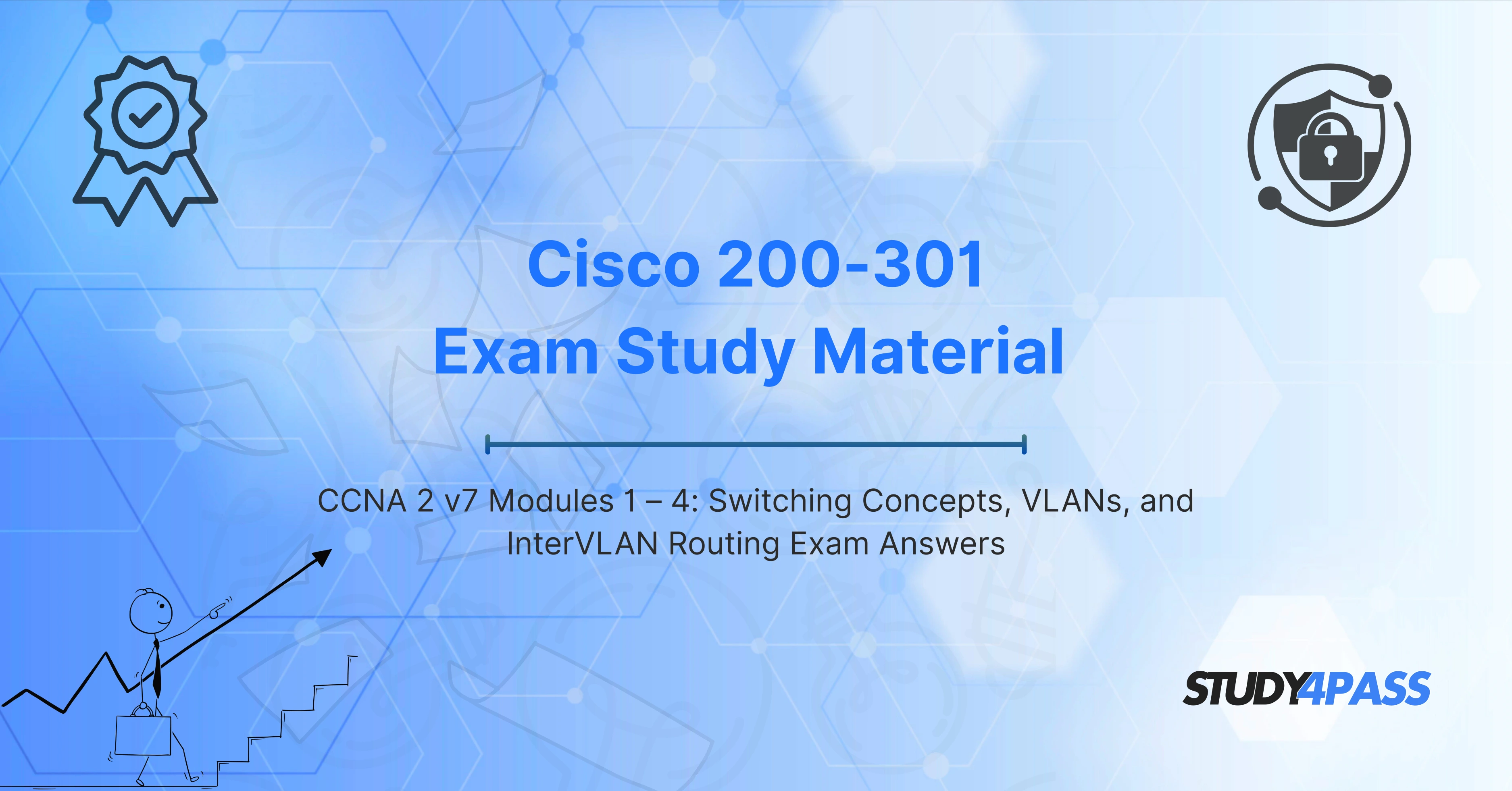Introduction
The Cisco Certified Network Associate (CCNA) 200-301 certification is a globally recognized credential that validates your skills in networking fundamentals, IP services, security, and automation. One of the key topics in the CCNA 2 v7 curriculum covers Switching Concepts, VLANs, and InterVLAN Routing (Modules 1-4).
This 4000-word guide provides an in-depth explanation of these topics, along with exam answers, study materials, and preparation tips to help you pass the CCNA 200-301 exam. Additionally, we recommend Study4Pass as a reliable resource for CCNA, CCDA, CCENT, CCNA Security, and CCNA Wireless exam preparation.
Switching Concepts in Networking
Ethernet Frame Structure
Ethernet frames are the fundamental units of data transmission in a network. A standard Ethernet frame includes:
- Preamble – Synchronizes communication.
- Destination MAC – Identifies the receiving device.
- Source MAC – Identifies the sending device.
- Type/Length – Specifies the protocol (IPv4/IPv6).
- Data (Payload) – Contains the actual information.
- FCS (Frame Check Sequence) – Ensures error-free transmission.
MAC Address Table
Switches use a MAC address table to forward frames efficiently. The table maps MAC addresses to corresponding switch ports. When a switch receives a frame:
- It checks the source MAC and updates its table.
- It checks the destination MAC and forwards the frame accordingly.
- If the destination MAC is unknown, the switch floods the frame to all ports (except the incoming port).
Switch Forwarding Methods
- Store-and-Forward – The switch receives the entire frame, checks for errors, then forwards it.
- Cut-Through – The switch forwards the frame immediately after reading the destination MAC (faster but less reliable).
- Fragment-Free – A compromise between the two, checks the first 64 bytes before forwarding.
Collision and Broadcast Domains
- Collision Domain – A network segment where data collisions can occur (reduced by switches).
- Broadcast Domain – A network segment where broadcast traffic is forwarded (controlled by routers and VLANs).
Virtual LANs (VLANs)
VLAN Basics and Benefits
A VLAN (Virtual Local Area Network) logically segments a physical network into multiple broadcast domains. Benefits include:
- Improved Security – Isolates sensitive traffic.
- Reduced Broadcast Traffic – Limits unnecessary broadcasts.
- Simplified Network Management – Groups devices by function (e.g., HR, Finance).
Types of VLANs
- Default VLAN (VLAN 1) – Preconfigured on all switches.
- Data VLAN – Carries user-generated traffic.
- Voice VLAN – Prioritizes VoIP traffic.
- Management VLAN – Used for switch administration.
- Native VLAN – Carries untagged traffic in trunking.
VLAN Trunking (802.1Q)
- Trunking allows multiple VLANs to traverse a single link between switches.
- 802.1Q is the standard protocol that inserts a VLAN tag into the Ethernet frame.
- Native VLAN remains untagged for backward compatibility.
VLAN Configuration on Cisco Switches
Creating a VLAN
Switch(config)# vlan 10
Switch(config-vlan)# name Sales
Assigning Ports to VLANs
Switch(config)# interface Gig0/1
Switch(config-if)# switchport mode access
Switch(config-if)# switchport access vlan 10
Configuring Trunk Ports
Switch(config)# interface Gig0/24
Switch(config-if)# switchport mode trunk
Switch(config-if)# switchport trunk allowed vlan 10,20,30
InterVLAN Routing
Router-on-a-Stick Configuration
This method uses a single router interface to route traffic between VLANs via sub-interfaces.
Configuration Steps
- Create VLANs on the Switch
- Configure Trunk Port to Router
- Set Up Sub-Interfaces on the Router
Router(config)# interface Gig0/0.10
Router(config-subif)# encapsulation dot1Q 10
Router(config-subif)# ip address 192.168.10.1 255.255.255.0
Layer 3 Switch InterVLAN Routing
A Layer 3 switch can perform routing without an external router.
Configuration Steps
Switch(config)# interface vlan 10
Switch(config-if)# ip address 192.168.10.1 255.255.255.0
Switch(config-if)# no shutdown
Troubleshooting VLAN and InterVLAN Issues
- Issue: Devices in different VLANs cannot communicate.
- Solution: Verify trunking and routing configurations.
- Issue: VLAN traffic not passing through trunk.
- Solution: Check allowed VLANs on trunk ports.
CCNA 200-301 Study Materials & Resources
Recommended Books
- "CCNA 200-301 Official Cert Guide Library" by Wendell Odom
- "31 Days Before Your CCNA Exam" by Allan Johnson
Online Courses & Practice Tests
- Cisco Networking Academy
- Udemy CCNA 200-301 Courses
- Study4Pass CCNA Practice Exams
Why Choose Study4Pass for CCNA Prep?
- Up-to-date exam dumps
- Real-world lab simulations
- Detailed explanations
- Affordable pricing
Study4Pass is an excellent platform for CCNA, CCDA, CCENT, CCNA Security, and CCNA Wireless exam preparation.
Conclusion
Mastering Switching Concepts, VLANs, and InterVLAN Routing is crucial for the CCNA 200-301 Exam. This guide has covered key topics, configuration examples, and exam answers to help you succeed.
For additional study materials and practice tests, visit Study4Pass a trusted resource for Cisco certification preparation.
Special Discount: Offer Valid For Limited Time “200-301 Exam Material”
Actual Exam Questions For Cisco's 200-301 Training
Sample Questions For Cisco 200-301 Exam Guide
1. What is the primary function of a switch in a network?
A) To connect multiple networks and route traffic between them
B) To forward traffic based on MAC addresses within a LAN
C) To filter traffic based on IP addresses
D) To provide wireless connectivity to end devices
2. Which of the following is a benefit of using VLANs?
A) Reducing the number of physical switches needed
B) Increasing the size of the broadcast domain
C) Grouping devices logically regardless of physical location
D) Eliminating the need for a router
3. What is required for communication between different VLANs?
A) A switch with multiple ports
B) A router or Layer 3 switch
C) A hub to extend the broadcast domain
D) A crossover cable between VLANs
4. Which command is used to assign a VLAN to an interface on a Cisco switch?
A) switchport mode access
B) vlan assign [vlan-id]
C) switchport access vlan [vlan-id]
D) ip vlan [vlan-id]
5. What is the purpose of the native VLAN in trunking?
A) To carry untagged traffic across a trunk link
B) To prioritize voice traffic
C) To block unauthorized VLANs
D) To assign a default gateway for VLANs

